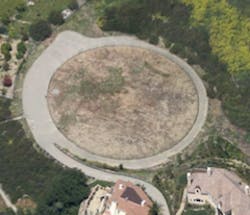Under the California Sun
The City of Covina, Calif., faces water quality challenges that are typical for many urban and suburban water systems across the southern United States. Nestled in the heart of the greater Los Angeles area, Covina receives water from several sources and distributes finished water through multiple pressure zones. With large variations in seasonal demand, operators must balance maintaining supply and reducing water age with requirements for emergency preparedness.
The problem
While overall water quality throughout the service area was very good, operators struggled with one section of their distribution system that was fed from a 5-mg underground tank—the largest tank in their system. Even though this tank was below grade and well insulated, operators could tell that the water inside was thermally stratified and poorly mixed. When opening the tank hatch on a warm day, operators were hit with a blast of hot, humid air that indicated that the surface water inside the tank was quite warm. Spot measurements showed that surface water temperatures were 10 to 20°F warmer than the bottom water layer during summer months. Disinfectant residual levels entering the tank were typically around 1.0 ppm, but water leaving the tank had only 0.5 ppm of disinfectant residual or less. By the time this low-residual water reached the far end of the system, residual levels were unacceptably low.
Operators developed a practice of manually boosting residual levels in the 5-mg tank. A recirculating pump system at the tank site allowed them to feed disinfectant into a stream of water in order to disperse the disinfectant, but it was uncertain whether this achieved adequate mixing.
“The procedure was cumbersome and time-consuming,” said City of Covina Operations Supervisor Dean Dospital. “I don’t like having my operators handling all of those chemicals.”
The solution
A visit by Brian Doane of D&H Water Systems in 2009 was the first exposure the Covina team had to active mixing and its potential to improve residual retention in water storage tanks. D&H Water Systems specializes in water quality equipment, including chemical feed systems and active mixing technology. Doane presented the PAX Water Mixer to Covina and proposed a trial to demonstrate its performance. Using submersible temperature probes, Doane showed that the 5-mg tank was thermally stratified—warm water was trapped in the top of the tank, leading to high water age, high surface water temperatures and accelerated disinfectant residual consumption.
The Covina team hired a diver to install the PAX Water Mixer in the center of the 5-mg tank. After turning the unit on, operators at Covina saw their thermal stratification problem disappear. Completely mixed conditions were established after only a few hours, and residual levels inside the tank improved dramatically. Whereas operators had been routinely dosing between 10 and 15 lb of hypochlorite solution into the tank before the mixer was installed, they were able to completely eliminate disinfectant boosting after the mixer was installed and running.
“From the time we installed the mixer, I noticed we were retaining residual,” said Dospital. “That was a big selling point.”
Subsequent temperature monitoring for the next six months showed that the tank remained completely mixed under all weather conditions. After the early success of the PAX Water Mixer, the Covina team proceeded with a full cleaning of the tank. This would ensure that, with constant movement provided by the mixer, sediment accumulation inside the tank would be reduced.
The results
Since the installation of the PAX Water Mixer in 2010, water quality conditions in the 5-mg tank have remained under control.
“It has become a trouble-free tank,” said Dospital. “It’s really what I always wanted.”
In 2013, Covina green-lighted additional mixers for four other tanks in its system. These tanks do not have quite as severe a residual problem as the 5-mg tank did, but during periods of low water use (in the winter), turnover in these tanks is low.
“In two of our tanks, we installed the mixer ourselves,” said Dospital. “It makes me feel a lot better knowing that the water in my tanks is always moving.”
